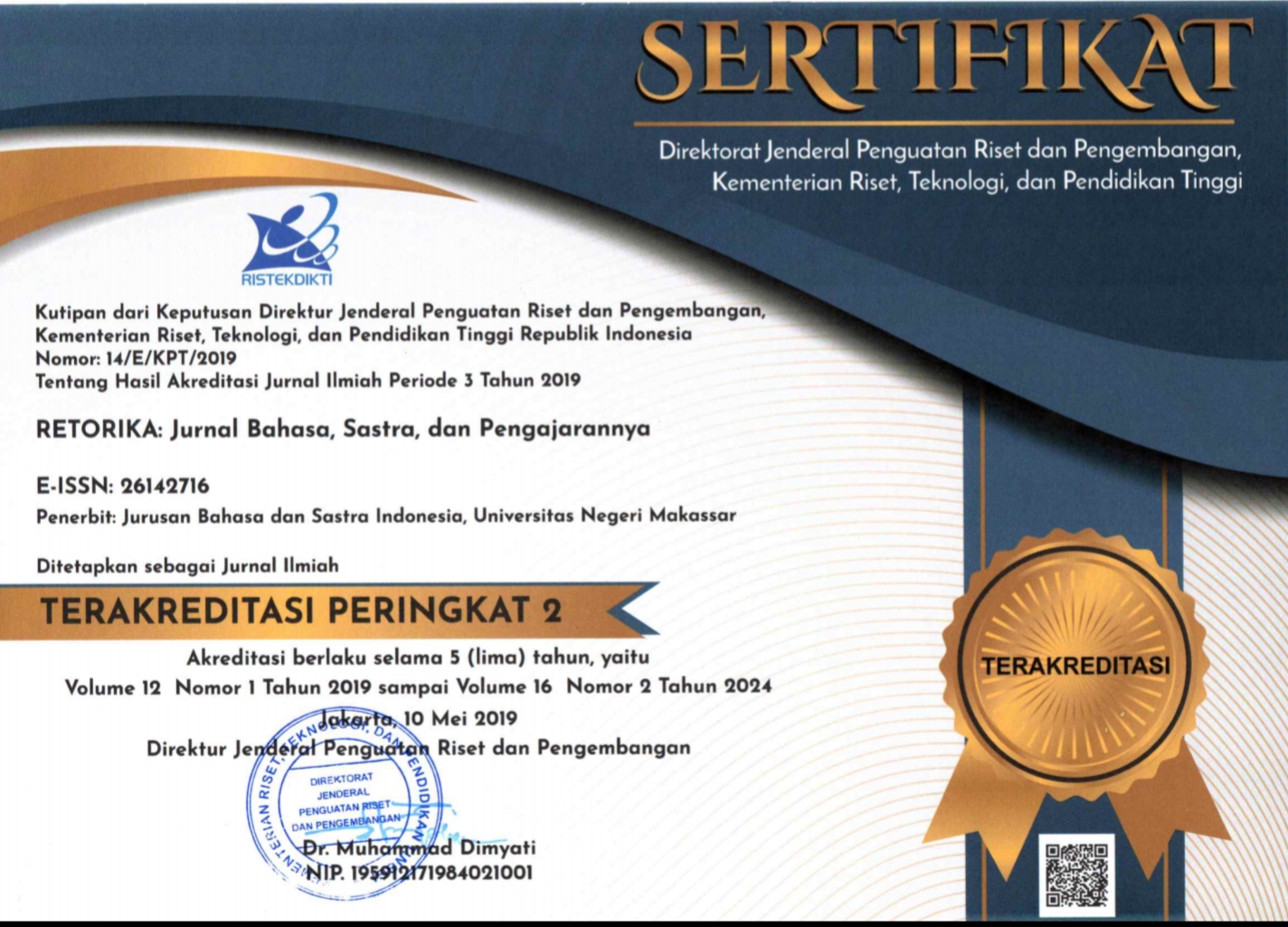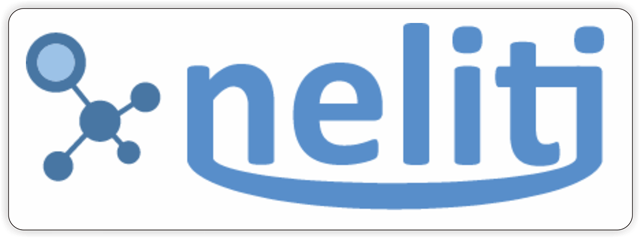TEACHERS’ SPEECH TO STIMULATE STUDENTS IN LEARNING INTERACTION
(1) Universitas Negeri Malang, Indonesia
(2) Universitas Negeri Malang, Indonesia
(3) Universitas Negeri Malang, Indonesia
(4) Universitas Brawijaya, Indonesia
(*) Corresponding Author
DOI: https://doi.org/10.26858/retorika.v14i1.19055
Abstract
Many learning theories and studies on classroom discourse explain that teachers’ speech has an important role in determining student learning success. The teachers’ speech in teaching-learning interactions influences the activity and comfort of students’ learning. This study aimed to describe how the teachers’ speech stimulates students in learning interaction. This study used a qualitative approach to the type of classroom research. Participants in this study were 4 teachers who taught Indonesian, Mathematics, Science, and English at Mts. Islamiyah. Data of the study were the teachers’ speech and its context of stimulating students in learning interaction. The data collected through classroom observations and recording of teachers’ speech and the context of the speech. By qualitative analysis, this study found that the teachers’ speech at the beginning of learning, in the learning process, and at the end of learning has various types and functions depending on the speech context underlying the speech events in the classroom interaction. The speech context includes students as audiences, speech functions, learning material as speech topics, learning interactions as speech situations. The use of teachers’ speech was a learning strategy conducted by teachers to stimulate students motivated for learning.
Keywords
Full Text:
PDFReferences
Andewi, W., & Waziana, W. (2019). An Analysis of Teacher’s Speech Acts in Teaching and Learning Process. Teknosastik, 17(1), 29–34. https://doi.org/10.33365/ts.v17i1.207.
Borer, B. (2018). Teaching And Learning Pragmatics And Speech Acts: An Instructional Pragmatics Curriculum Development Project For EFL Learners. https://digitalcommons.hamline.edu/cgi/viewcontent.cgi?article=1179&context=hse_cp.
Boyd, M. P. (2015). Relations Between Teacher Questioning and Student Talk in One Elementary ELL Classroom. Journal of Literacy Research, 47(3), 370–404. https://doi.org/10.1177/1086296X16632451.
Bruce, B., & Hansson, K. (2011). Promoting Peer Interaction. Autism Spectrum Disorders - From Genes to Environment. https://doi.org/10.5772/20034.
Buzzelli, C., & Johnston, B. (2014). The Moral Dimensions of Teaching: Language, Power, and Culture in Classroom Interaction. London: Routledge.
Cao, Y. (2011). Investigating situational willingness to communicate within second language classrooms from an ecological perspective. System, 39(4), 468–479. https://doi.org/10.1016/j.system.2011.10.016.
Caraballe, M. R. S. (2015). The relationship between students’ learning styles and teachers’ teaching styles to students’ achievement. Asia Pacific Higher Education Research Journal (APHERJ), 2(2). http://po.pnuresearchportal.org/ejournal/index.php/apherj/article/view/105.
Celce-Murcia, M., Brinton, D., & Snow, M. A. (2014). Teaching English as a second or foreign language. National Geographic Learning : Heinle Cengage Learning.
Che Ahmad, C. N., Shaharim, S. A., & Abdullah, M. (2017). Teacher-student interactions, learning commitment, learning environment and their relationship with student learning comfort. Journal of Turkish Science Education, 14, 57–72. https://doi.org/10.12973/tused.10190a.
Dimyati, & Mudjiono. (2013). Belajar dan Pembelajaran. Jakarta: Rineke Cipta.
Dunleavy, J., & Milton, P. (2009). What did you do in school today? Exploring the Concept of Student Engagement and its Implications for Teaching and Learning in Canada. Canadian Education Association (CEA), May, 2009.
Fraser, B. J. (2012). Classroom Learning Environments: Retrospect, Context and Prospect. In B. J. Fraser, K. Tobin, & C. J. McRobbie (Eds.), Second International Handbook of Science Education (pp. 1191–1239). Springer Netherlands. https://doi.org/10.1007/978-1-4020-9041-7_79.
Garrels, V. (2019). Getting good at small talk: Student-directed learning of social conversation skills. European Journal of Special Needs Education, 34(3), 393–402. https://doi.org/10.1080/08856257.2018.1458472.
Hamalik, O. (2013). Kurikulum dan Pembelajaran. Jakarta: PT. Bumi Aksara.
Hikmah, N., Bahari, Y., & Imran. (2015). Peranan Guru dalam Membina Perilaku Siswa Bermasalah pada Proses Belajar Mengajar Sosiologi. Jurnal Pendidikan Dan Pembelajaran, 4(12), http://jurnal.untan.ac.id/index.php/jpdpb/article/view/12826.
Howarth, P. (2013). Increasing student interaction. TeachingEnglish | British Council | BBC. https://www.teachingenglish.org.uk/article/increasing-student-interaction.
Ismail, A. O., Mahmood, A. K., & Abdelmaboud, A. (2018). Factors Influencing Academic Performance of Students in Blended and Traditional Domains. International Journal of Emerging Technologies in Learning (IJET), 13(02), 170–187. https://doi.org/10.3991/ijet.v13i02.8031.
Lang, J. M. (2017, October 26). Small Changes in Teaching: The First 5 Minutes of Class. The Teaching Center. https://teachingcenter.wustl.edu/2017/10/small-changes-first-5-minutes/.
Lieber, C. M. (2002). Partners in learning: From conflict to collaboration in secondary classrooms. Educators for Social Responsibility.
Long, C., Ming, Z., & Chen, L. (2013). The Study of Student Motivation on English Learning in Junior Middle School—A Case Study of No.5 Middle School in Gejiu. English Language Teaching, 6(9). https://doi.org/10.5539/elt.v6n9p136.
Nasir, C., Yusuf, Y. Q., & Wardana, A. (2019). A qualitative study of teacher talk in an EFL classroom interaction in Aceh Tengah, Indonesia. Indonesian Journal of Applied Linguistics, 8(3), 525–535. https://doi.org/10.17509/ijal.v8i3.15251.
Park, M. Y. (2014). Teachers’ Use Speech Style in the Korean Language Classroom. https://pdfs.semanticscholar.org/8cdf/2269a1760d74c22ec9c9127504cb9ded14b5.pdf.
Pfingsthorn, J. (2012). Teaching and Learning Pragmatics: Where Language and Culture Meet: Noriko Ishihara, Andrew D. Cohen, Longman Applied Linguistics, 2010, 370 pp., ISBN 978-1408204573, EUR 27,99. Journal of Pragmatics, 44(4), 538–540. https://doi.org/10.1016/j.pragma.2012.02.004.
Ramirez‐Arellano, A., Acosta‐Gonzaga, E., Bory‐Reyes, J., & Hernández‐Simón, L. M. (2018). Factors affecting student learning performance: A causal model in higher blended education. Journal of Computer Assisted Learning, 34(6), 807–815. https://doi.org/10.1111/jcal.12289.
Redondo, & Jose. (2015). Motivation: The Road to Successful Learning . Jurnal: Teachers’ Professional Development, 17(2), 125—136. http://dx.doi.org/10.15446/profile.v17n2.50563.
Sardiman. (2012). Interaksi Dan Motivasi Belajar Mengajar. Jakarta: PT RajaGrafindo Persada.
Sharpe, T. (2008). How can teacher talk support learning? Linguistics and Education, 19, 132–148. https://doi.org/10.1016/j.linged.2008.05.001.
Shleykina, G. (2019). The Interlanguage Pragmatics of Greetings. http://journal.wima.ac.id/index.php/BW/article/view/1848/0.
Smith, G. A. (2008, December 16). First-Day Questions for the Learner-Centered Classroom [The National Teaching & Learning Forum]. T.I.P.S. for Faculty. https://tipsforfaculty.com/2008/12/16/smith-first-day-questions-for-the-learner-centered-classroom-%ef%bf%bc%ef%bf%bc/.
Steedly, K. M., Levin, M., Schwartz, A., & Luke, S. D. (2008). Social Skills and Academic Achievement. Evidence for Education, III(II), 8. http://www.parentcenterhub.org/wp-content/uploads/repo_items/eesocialskills.pdf.
van der Meij, H., van der Meij, J., Voerman, T., & Duipmans, E. (2018). Supporting motivation, task performance and retention in video tutorials for software training. Educational Technology Research and Development, 66(3), 597–614. https://doi.org/10.1007/s11423-017-9560-z.
Wang, Q., & Castro, C. D. (2010). Classroom Interaction and Language Output. English Language Teaching, 3(2). https://doi.org/10.5539/elt.v3n2p175.
Washington University. (2009). Increasing Student Participation. The Teaching Center. https://teachingcenter.wustl.edu/resources/teaching-methods/participation/increasing-student-participation/.
Wells, G. (1999). Dialogic inquiry: Towards a sociocultural practice and theory of education. Cambridge University Press. https://doi.org/10.1017/CBO9780511605895.
Wicaksono, B. H. (2016). Teacher’s Talk Role in Teaching Speaking. Proceedings of ISELT FBS Universitas Negeri Padang, 4(1), 123–131. http://ejournal.unp.ac.id/index.php/selt.
Yale Center for Teaching and Learning. (2019). The Beginning and End of Class | Poorvu Center for Teaching and Learning. https://poorvucenter.yale.edu/Beginning-End-Class.
Yusuf, F. N., & Novita, O. E. (2020). EFL teachers’ perceived language proficiency and teaching effectiveness. Indonesian Journal of Applied Linguistics, 9(3), 580–588. https://doi.org/10.17509/ijal.v9i3.23208.
Article Metrics
Abstract view : 515 times | PDF view : 91 timesRefbacks
- There are currently no refbacks.
Copyright (c) 2021 Imam Suyitno

This work is licensed under a Creative Commons Attribution-NonCommercial 4.0 International License.
Published by:
Department of Indonesian Language, Faculty of Languages and Literature, Universitas Negeri Makassar in cooperate with Asosiasi Dosen Bahasa dan Sastra Indonesia (ADOBSI) and Ikatan Program Studi Pendidikan Bahasa dan Sastra Indonesia (IKAPROBSI).
Address: Department of Indonesian Language Office, DG Building Second Floor, UNM Parangtambung, Daeng Tata Raya Street, Makassar, South Sulawesi, Indonesia
 Email: retorika@unm.ac.id
Email: retorika@unm.ac.id

RETORIKA: Jurnal Bahasa, Sastra,dan Pengajarannya is licensed under a Creative Commons Attribution-NonCommercial 4.0 International License.
















